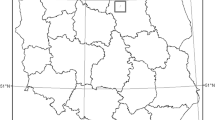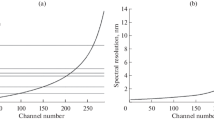Abstract
Computational schemes for forest vegetation identification on airborne hyperspectral images are implemented using the feature of the red edge in the transition region from the chlorophyll absorption band to the maximum spectral reflectance of vegetation and taking into account integral brightness values of the detected spectra. Based on the proposed models, pixel-by-pixel and textural identification of forest vegetation of different types and ages is carried out within a window of a certain size. New possibilities for the identification of the selected types of objects are shown when comparing the obtained results with the data of ground-based forest-taxation surveys of the test area.








Similar content being viewed by others
REFERENCES
Beaubien, J., Cihlar, J., Simard, G., and Latifovic, R., Land cover from maltiple thematic mapper scenes using a new enhancement classification methodology, J. Geophys. Res., 1999, vol. 104, no. D22, pp. 27909–27920.
Bondur, V.G., Modern approaches to processing large hyperspectral and multispectral aerospace data flows, Izv., Atmos. Ocean. Phys., 2014, vol. 50, no. 9, pp. 840–852. https://doi.org/10.1134/S0001433814090060
Bunting, P. and Lucas, R., The delineation of tree crowns in Australian mixed species forests using hyperspectral Compact Airborne Spectrographic Imager (CASI) data, Remote Sens. Environ., 2006, vol. 101, pp. 230–248.
Cho, M.A. and Skidmore, A.K., A new technique for extracting the red edge position from hyperspectral data: The linear extrapolation method, Remote Sens. Environ., 2006, vol. 101, pp. 181–193.
Dalponte, M., Bruzzone, L., Vescovo, L., and Gianelle, D., The role of spectral resolution and classifier complexity in the analysis of hyperspectral images of forest area, Remote Sens. Environ., 2009, vol. 113, pp. 2345–2355.
Egorov, V.D. and Kozoderov, V.V., Increasing the calculation efficiency of programs for the estimations of soil–vegetation cover parameters according to multispectral remote sensing data, Issled. Zemli Kosmosa, 2009, no. 5, pp. 11–21.
Fuentes, D.A., Gamon, J.A., Qu, H.L., Sims, D.A., and Roberts, D.A., Mapping Canadian boreal forest vegetation using pigment and water absorption features derived from the AVIRIS sensor, J. Geophys. Res., 2001, vol. 106, no. D24, pp. 33565–33577.
Gamon, J.A., Huemmrich, K.F., Peddle, D.R., et al., Remote sensing in BOREAS: Lessons learned, Remote Sens. Environ., 2004, vol. 89, pp. 139–162.
Goodenough, D.G., Niemann, K.O., Dyk, A., Hobart, G., Gordon, P., Loisel, M., et al., Comparison of AVIRIS and AISA airborne hyperspectral sensing for above-ground forest carbon mapping, IEEE Int. Geosci. Remote Sens. Symp. 2008, IGARSS 2008, vol. 2, pp. II_129–II_132.
Jones, T.G., Coops, N.C., and Sharma, T., Assessing the utility of airborne hyperspectral and LiDAR data for species distribution mapping in the coastal Pacific Northwest, Canada, Remote Sens. Environ., 2010, vol. 114, pp. 2841–2852.
Kozoderov, V.V. and Egorov, V.D., Vegetation pattern recognition using hyperspectral air sounding data, Izv., Atmos. Ocean. Phys., 2011, vol. 47, no. 9, pp. 1135–1142.
Kozoderov, V.V. and Egorov, V.D., Automation of hyperspectral airborne remote sensing data processing, Izv., Atmos. Ocean. Phys., 2014, vol. 50, no. 9, pp. 853–866.
Kozoderov, V.V. and Kondranin, T.V., Metody otsenki sostoyaniya pochvenno-rastitel’nogo pokrova po dannym opticheskikh sistem distantsionnogo aerokosmicheskogo zondirovaniya (Methods for Assessing the State of the Soil and Vegetation Cover from the Data of Optical Systems of Remote Aerospace Sensing), Moscow: Mosk. Fiz. Tekh. Inst., 2008.
Meroni, M., Busetto, L., Colombo, R., Guanter, L., Moreno, J., and Verhoef, W., Performance of spectral fitting methods for vegetation fluorescence quantification, Remote Sens. Environ., 2010, vol. 114, pp. 363–374.
Zarco-Tejada, P.J. and Miller, J.R., Land cover mapping at BOREAS using red edge spectral parameters from CASI imagery, J. Geophys. Res., 1999, vol. 104, no. D22, pp. 27921–27933.
ACKNOWLEDGMENTS
This study was supported by the Russian Foundation for Basic Research, project nos. 13-01-00185, 14-05-00598, and 14-07-00141.
Author information
Authors and Affiliations
Corresponding author
Ethics declarations
The authors declare that they have no conflict of interest.
Additional information
Translated by O. Pismenov
APPENDIX
APPENDIX
Color Scale of Surface Types in Figs. 5 –8
Object classes are arranged in order of increasing brightness (REP): (0–1) water, (2) dirt road surface, (3–4) ground surface, (5) yellowing vegetation; (6‒20) forest vegetation of different age structure: (6‒10) pine, (11–17) birch, (18–20) spruce; (21‒24) clearing, (25) marsh, and (26) meadow vegetation; and (27) hard road surface, (28) quarry, and (–1) unidentified object.
Rights and permissions
About this article
Cite this article
Egorov, V.D., Kozoderov, V.V. Identification of Forest Vegetation Using Airborne Hyperspectral Data. Izv. Atmos. Ocean. Phys. 57, 1538–1548 (2021). https://doi.org/10.1134/S0001433821120288
Received:
Revised:
Accepted:
Published:
Issue Date:
DOI: https://doi.org/10.1134/S0001433821120288




